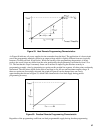
82
Figure 55. Remote Programming Connections
The wire size of the programming leads must be adequate to withstand any programming surges (consider
effects of any large storage capacitors which have to be charged or discharged through the programming leads).
The temperature coefficient of a very long programming leads may degrade power supply temperature
coefficient and drift specifications. This is particularly true if the power supply is exceptionally well regulated,
or the programming leads are subjected to considerable ambient temperature changes, or when programming is
done with low resistance values.
Protecting Against Momentary Programming Errors
Using remote programming, several different values of fixed output voltage are obtainable with resistors and a
switch, so that the output voltage of the supply can be switched to any pre-established value with a high degree
of reproducibility. Figure 56 illustrates several switching techniques that can be used in conjunction with
resistance programming.
Suppose it is desired to program a supply having a programming coefficient K
P
of 200/ohms volt to any of three
values--5 volts, 10 volts, and 15 volts; the circuit of Figure 56A is a typical configuration. However, if a
break-before-make switch is used in the configuration of Figure 56A, there will occur for a short interval during
the switching action, a very high resistance between the two programming terminals, and the power supply
during that interval will raise its output voltage in response to this high resistance input.
To eliminate this output overshoot corresponding to an infinite programming resistance, a make-before-break
switch should be employed. However, this solution has the disadvantage that during the short interval when the
swinger of the switch is contacting two switch terminals, two programming resistors will momentarily be
paralleled across the power supply programming terminals, and the supply will for this short interval seek an
output voltage which is lower than either the initial or the final value being programmed. This output
undershoot increases the time required for the supply to settle to its new value.
The switching circuit of Figure 56B, using a make-before-break switch, eliminates both the overshoot and the
undershoot problems associated with Figure 56B. When the switch is rotated clockwise the resistance value
between the two programming terminals will go directly from 1000 to 2000 ohms, and then from 2000 to 3000


















